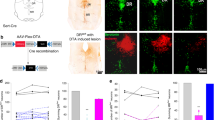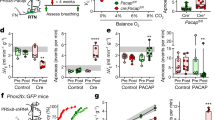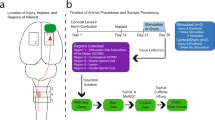Abstract
Intermittent hypoxia causes a form of serotonin-dependent synaptic plasticity in the spinal cord known as phrenic long-term facilitation (pLTF). Here we show that increased synthesis of brain-derived neurotrophic factor (BDNF) in the spinal cord is necessary and sufficient for pLTF in adult rats. We found that intermittent hypoxia elicited serotonin-dependent increases in BDNF synthesis in ventral spinal segments containing the phrenic nucleus, and the magnitude of these BDNF increases correlated with pLTF magnitude. We used RNA interference (RNAi) to interfere with BDNF expression, and tyrosine kinase receptor inhibition to block BDNF signaling. These disruptions blocked pLTF, whereas intrathecal injection of BDNF elicited an effect similar to pLTF. Our findings demonstrate new roles and regulatory mechanisms for BDNF in the spinal cord and suggest new therapeutic strategies for treating breathing disorders such as respiratory insufficiency after spinal injury. These experiments also illustrate the potential use of RNAi to investigate functional consequences of gene expression in the mammalian nervous system in vivo.
This is a preview of subscription content, access via your institution
Access options
Subscribe to this journal
Receive 12 print issues and online access
$209.00 per year
only $17.42 per issue
Buy this article
- Purchase on Springer Link
- Instant access to full article PDF
Prices may be subject to local taxes which are calculated during checkout





Similar content being viewed by others
References
Mitchell, G.S. & Johnson, S.M. Neuroplasticity in respiratory motor control. J. Appl. Physiol. 94, 358–374 (2003).
Feldman, J.L., Mitchell, G.S. & Nattie, E.E. Breathing: rhythmicity, plasticity and chemosensitivity. Annu. Rev. Neurosci. 26, 239–266 (2003).
Baker, T.L., Fuller, D.D., Zabka, A.G. & Mitchell, G.S. Respiratory plasticity: differential actions of continuous and episodic hypoxia and hypercapnia. Respir. Physiol. 129, 25–35 (2001).
Mitchell, G.S. et al. Intermittent hypoxia and respiratory plasticity. J. Appl. Physiol. 90, 2466–2475 (2001).
Prabhakar, N.R. Oxygen sensing during intermittent hypoxia: cellular and molecular mechanisms. J. Appl. Physiol. 90, 1986–1994 (2001).
Fuller, D.D., Zabka, A.G., Baker, T.L. & Mitchell, G.S. Phrenic long-term facilitation requires 5-HT receptor activation during but not following episodic hypoxia. J. Appl. Physiol. 90, 2001–2006 (2001).
Baker-Herman, T.L. & Mitchell, G.S. Phrenic long-term facilitation requires spinal serotonin receptor activation and protein synthesis. J. Neurosci. 22, 6239–6246 (2002).
Thoenen, H. Neurotrophins and neuronal plasticity. Science 270, 593–598 (1995).
Thoenen, H. Neurotrophins and activity-dependent plasticity. Prog. Brain Res. 128, 183–191 (2000).
Black, I.B. Trophic regulation of synaptic plasticity. J. Neurobiol. 41, 108–118 (1999).
Schinder, A.F. & Poo, M-m. The neurotrophin hypothesis for synaptic plasticity. Trends Neurosci. 23, 639–645 (2000).
Poo, M-m. Neurotrophins as synaptic modulators. Nat. Rev. Neurosci. 2, 1–9 (2001).
Bach, K.B. & Mitchell, G.S. Hypercapnia-induced long-term depression of respiratory activity requires α2-adrenergic receptors. J. Appl. Physiol. 84, 2099–2105 (1998).
Fire, A. et al. Potent and specific genetic interference by double-stranded RNA in Caenorhabditis elegans. Nature 391, 806–811 (1998).
Hammond, S.M., Bernstein, E., Beach, D. & Hannon, G.J. An RNA-directed nuclease mediates post-transcriptional gene silencing in Drosophila cells. Nature 404, 293–296 (2000).
Bavis, R.W. & Mitchell, G.S. Intermittent hypoxia induces phrenic long-term facilitation in carotid-denervated rats. J. Appl. Physiol. 94, 399–409 (2003).
Solomon, I.C. Excitation of phrenic and sympathetic output during acute hypoxia: contribution of medullary oxygen detectors. Respir. Physiol. 121, 101–117 (2000).
Bodineau, L. & Larnicol, N. Brainstem and hypothalamic areas activated by tissue hypoxia: Fos-like immunoreactivity induced by carbon monoxide inhalation in the rat. Neuroscience 108, 643–653 (2001).
Kokaia, Z. et al. Regional brain-derived neurotrophic factor mRNA and protein levels following transient forebrain ischemia in the rat. Brain Res. Mol. Brain Res. 38, 139–144 (1996).
Blitz, D.M. & Rameriz, J.M. Long-term modulation of respiratory network activity following anoxia in vitro. J. Neurophysiol. 87, 2964–2971 (2002).
Patterson, S.L., Grover, L.M., Schwartzkroin, P.A. & Bothwell, M. Neurotrophin expression in rat hippocampal slices: a stimulus paradigm inducing LTP in CA1 evokes increases in BDNF and NT-3 mRNAs. Neuron 9, 1081–1088 (1992).
Richerson, G.B., Wang, W., Tiwari, J. & Bradley, S.R. Chemosensitivity of serotonergic neurons in the rostral ventral medulla. Respir. Physiol. 129, 175–190 (2001).
Veasey, S.C., Fornal, C.A., Metzler, C.W. & Jacobs, B.L. Response of serotonergic caudal raphe neurons in relation to specific motor activities in freely moving cats. J. Neurosci. 15, 5346–5359 (1995).
Uchino, H., Lindvall, O., Siesjo, B.K. & Kokaia, Z. Hyperglycemia and hypercapnia suppress BDNF gene expression in vulnerable regions after transient forebrain ischemia in the rat. J. Cereb. Blood Flow Metab. 17, 1303–1308 (1997).
Caplen, N.J., Parrish, S., Imani, F., Fire, A. & Morgan, R.A. Specific inhibition of gene expression by small double-stranded RNAs in invertebrate and vertebrate systems. Proc. Natl. Acad. Sci. USA 98, 9742–9747 (2001).
Elbashir, S.M. et al. Duplexes of 21-nucleotide RNAs mediate RNA interference in cultured mammalian cells. Nature 411, 494–498 (2001).
Anonymous editorial. Whither RNAi? Nat. Cell Biol. 5, 489–490 (2003).
Basura, G.J., Zhou, S.Y., Walker, P.D. & Goshgarian, H.G. Distribution of serotonin 2A and 2C receptor mRNA expression in the cervical ventral horn and phrenic motoneurons following spinal cord hemisection. Exp. Neurol. 169, 255–263 (2001).
Balkowiec A. & Katz, D.M. Activity-dependent release of endogenous brain-derived neurotrophic factor from primary sensory neurons detected by ELISA in situ. J. Neurosci. 20, 7417–7423 (2000).
Tongiorgi, E., Righi, M. & Cattaneo, A. Activity-dependent dendritic targeting of BDNF and TrkB mRNAs in hippocampal neurons. J. Neurosci. 17, 9492–9505 (1997).
Li, Y.X., Zhang, Y., Lester, H.A., Schuman, E.M. & Davidson, N. Enhancement of neurotransmitter release induced by brain-derived neurotrophic factor in cultured hippocampal neurons. J. Neurosci. 18, 10231–10240 (1998).
Schinder, A.F., Berninger, B. & Poo, M. Postsynaptic target specificity of neurotrophin-induced presynaptic potentiation. Neuron 25, 151–163 (2000).
Levine, E.S., Crozier, R.A., Black, I.B. & Plummer, M.R. Brain-derived neurotrophic factor modulates hippocampal synaptic transmission by increasing N-methyl-D-aspartic acid receptor activity. Proc. Natl. Acad. Sci. USA 95, 10235–10239 (1998).
Grosshans, D.R., Clayton, D.A., Coultrap, S.J. & Browning, M.D. LTP leads to rapid surface expression of NMDA but not AMPA receptors in adult rat CA1. Nat. Neurosci. 5, 27–33 (2002).
Malinow, R. & Malenka, R.C. AMPA receptor trafficking and synaptic plasticity. Annu. Rev. Neurosci. 25, 103–126 (2002).
Tanaka, T., Saito, H. & Matsuki, N. Inhibition of GABAA synaptic responses by brain-derived neurotrophic factor (BDNF) in rat hippocampus. J. Neurosci. 17, 2959–2966 (1997).
Kafitz, K.W., Rose, C.R., Thoenen, H. & Konnerth, A. Neurotrophin-evoked rapid excitation through TrkB receptors. Nature 401, 918–921 (1999).
Ling, L. et al. Chronic intermittent hypoxia elicits serotonin-dependent plasticity in the central neural control of breathing. J. Neurosci. 21, 5381–5388 (2001).
Kinkead, R. et al. Cervical dorsal rhizotomy enhances serotonergic innervation of phrenic motoneurons and serotonin-dependent long-term facilitation of phrenic motor output in rats. J. Neurosci. 18, 8436–8443 (1998).
Johnson, R.A., Okragly, A.J., Haak-Frendscho, M. & Mitchell, G.S. Cervical dorsal rhizotomy increases brain-derived neurotrophic factor and neurotrophin-3 expression in the ventral spinal cord. J. Neurosci. 20, RC771–5 (2000).
Kinney, H.C., Filiano, J.J. & White, W.F. Medullary serotonergic network deficiency in the sudden infant death syndrome: review of a 15-year study of a single dataset. J. Neuropathol. Exp. Neurol. 60, 228–247 (2001).
Strollo, P.J. & Rogers, R.M. Obstructive sleep apnea. N. Engl. J. Med. 334, 99–104 (1996).
Bixler, E.O. et al. Prevalence of sleep-disordered breathing in women: effects of gender. Am. J. Respir. Crit. Care Med. 163, 608–613 (2001).
Young, T., Peppard, P.E. & Gottlieb, D.J. Epidemiology of obstructive sleep apnea: a population health perspective. Am. J. Respir. Crit. Care Med. 165, 1217–1239 (2002).
Veasey, S.C., Panckeri, K.A., Hoffman, E.A., Pack, A.I. & Hendricks, J.C. The effects of serotonin antagonists in an animal model of sleep-disordered breathing. Am. J. Respir. Crit. Care Med. 153, 776–786 (1996).
Zabka, A.G., Behan, M. & Mitchell, G.S. Long term facilitation of respiratory motor output decreases with age in male rats. J. Physiol. 531, 509–514 (2001).
Jackson, A.B. & Groomes, T.E. Incidence of respiratory complication following spinal cord injury. Arch. Phys. Med. Rehabil. 75, 270–275 (1994).
Mansel, J.K. & Norman, J.R. Respiratory complications and management of spinal cord injuries. Chest 97, 1446–1452 (1990).
Fuller, D.D., Johnson, S.M., Olson, E.B. Jr. & Mitchell, G.S. Synaptic pathways to phrenic motoneurons are enhanced by chronic intermittent hypoxia following cervical spinal cord injury. J. Neurosci. 23, 2993–3000 (2003).
Thoenen, H. & Sendtner, M. Neurotrophins: from enthusiastic expectations through sobering experiences to rational therapeutic approaches. Nat. Neurosci. 5, 1046–1050 (2002).
Acknowledgements
These experiments were supported by National Institutes of Health (NIH) grant HL 65383. T.L.B.-H. and R.W.B. were supported by NIH Training Grant HL 07654. D.D.F. was supported by the Parker B. Francis Foundation. F.J.G. was supported by a Christopher Reeve Paralysis Foundation Fellowship (GA1-0305-2). We thank B. Hodgeman for technical assistance.
Author information
Authors and Affiliations
Corresponding author
Ethics declarations
Competing interests
The authors declare no competing financial interests.
Rights and permissions
About this article
Cite this article
Baker-Herman, T., Fuller, D., Bavis, R. et al. BDNF is necessary and sufficient for spinal respiratory plasticity following intermittent hypoxia. Nat Neurosci 7, 48–55 (2004). https://doi.org/10.1038/nn1166
Received:
Accepted:
Published:
Issue Date:
DOI: https://doi.org/10.1038/nn1166
This article is cited by
-
Passive limb training modulates respiratory rhythmic bursts
Scientific Reports (2023)
-
Potential Plausible Role of Stem Cell for Treating Depressive Disorder: a Retrospective Review
Molecular Neurobiology (2023)
-
Anxiolytic and antidepressants’ effect of Crataegus pinnatifida (Shan Zha): biochemical mechanisms
Translational Psychiatry (2022)
-
Systemic inflammation suppresses spinal respiratory motor plasticity via mechanisms that require serine/threonine protein phosphatase activity
Journal of Neuroinflammation (2021)
-
A Tellurium-Based Small Immunomodulatory Molecule Ameliorates Depression-Like Behavior in Two Distinct Rat Models
NeuroMolecular Medicine (2020)



